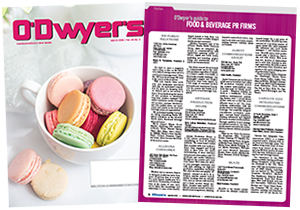|
|
Following the announcement of the 2015 U.S. Dietary Guidelines, which provided sweeping guidelines and population-level guidance about what to eat, some consumers are seeking assistance elsewhere, based on personal data from emerging tools.
Being a registered dietitian and a public relations professional who bridges the science of nutrition and the art of communication, I have a unique opportunity to see how both worlds work together in creating awareness and educating the public.
|
|
In the past few years, the rise of wearable technology and mobile apps has dominated conversations and share of spend. With these accessible forms of health tracking, personal data mining, and an increase in wellness messaging, the way we communicate with consumers is rapidly evolving from mass communicating to one-on-one touchpoints.
Before diving into the core of personalized nutrition, let’s start from the beginning. What exactly is personalized nutrition? To the medical community, it means nutrigenomics: how foods affect a person’s genes. To marketers, those in the communication fields, and even consumers, it means having a food and nutrition regime tailored to them, their disease state, or their health goal.
Since the completion of the human genome mapping in 2003, direct-to-consumer genetic testing companies, such as 23andMe, use biometrics to provide consumers with detailed reports on nutrient deficiencies and other potential conditions that would impact their health (e.g., caffeine consumption, lactose intolerance, etc.). While this testing sounds attractive at first blush, the Academy of Nutrition and Dietetics states that this is still an emerging field. Additional training for dietitians and enhanced regulation must be in place before this method of nutrition counseling can enter the mainstream.
From a practitioner’s standpoint, this type of testing does not provide a comprehensive recommendation on how to build and sustain a healthful lifestyle — namely meal planning, exercise and sleep. And, without properly communicating how to use the information these tests provide, consumers will continue to be frustrated by deciphering their health needs.
Personalized and private
Receiving real-time data on health measurements is one benefit of tracking. The information is unique and delivered to a wearable device or mobile phone — no blanket ranges of numbers, only exact numbers. But, a challenge hindering the widespread adoption of personalized nutrition is how to best protect people’s privacy. For most apps, personal information must be entered for tailored health outcomes. And, for direct-to-consumer genetic testing, laws on how to protect genetic material have not caught up to the potential ramifications on the security and release of the data. Despite some of these concerns, researchers still see the value in studying the viability of personalized nutrition as the next generation of disease prevention measures.
Searching for answers
One of the largest initiatives funded by the European Food Information Council is Food4me.org, a four-year research project currently in progress with eight European Union nations. At the helm of the project is Professor Mike Gibney of the Institute of Food and Health, University College Dublin, who manages a consortium of experts in a variety of fields including biological sciences, consumer studies, marketing, IT and technology, ethical and legal industries, and communication fields. Linking these industries to one study allows for better understanding to how consumers view and use personalized nutrition. The researchers aim to establish best practices for communicating personalized nutrition. The findings of this research will set the benchmark for practitioners, educators, and communication professionals on how to use nutrigenomics information to best help their audiences in achieving their health goals.
Personalized nutrition in practice
Even without having genetic material to guide a personalized nutrition plan, there is absolute power for consumers to know that they have control of their health and, more importantly, their data. They have the option of deciding which tools to use that will suit their health needs. Companies like ShopWell and Ingredient1 offer two different models of communicating success that meets consumers’ needs. ShopWell uses mobile product scans and enlists registered dietitians to score and recommend products that fit the user’s needs. This model allows the user to work within the guardrails of a ranking system. On the other hand, Ingredient1 allows consumers to create their food identity so they can discover foods that suit their regime, ultimately enabling them to customize their food and nutrition needs. Two different apps, two different ways of communicating personalized nutrition.
Attracting general consumers is already gaining momentum, but one company is looking forward and speaking to pregnant women with an eye on impacting the future generation in the womb. Nutrino, powered by IBM Watson, is merging personalized nutrition and artificial intelligence to help moms-to-be with decisions that matter outside of the doctor’s office. One-on-one communication that extends outside of the healthcare office provides comfort and support for women with a lot on their minds.
For consumers to fully embrace personalized nutrition, the tools and research must work together. If these tools are truly effective, one-to-one communication will soon overpower advice en masse. Ultimately, if the science can influence the consumer to initiate change while using technology to improve or maintain their health and create value, then the communication will produce the desired outcomes for all parties — researchers, health care professional, technology and, ultimately, the consumer.
* * *
Registered dietitian Jeannie Houchins represents food and nutrition clients at inVentiv Health company Allidura Consumer.




 What the biggest meal of the day can teach us about serving up effective nutrition communications campaigns.
What the biggest meal of the day can teach us about serving up effective nutrition communications campaigns. Tips to refine and amplify your CPG brand strategy to win in 2024 and beyond.
Tips to refine and amplify your CPG brand strategy to win in 2024 and beyond. Strategic communications strategies for success in the growing “food is medicine” movement.
Strategic communications strategies for success in the growing “food is medicine” movement. How brands can authentically communicate sustainability issues and create a brand experience that’s compatible with consumers’ values.
How brands can authentically communicate sustainability issues and create a brand experience that’s compatible with consumers’ values. Communicating the effects that climate change and a growing world population have on our food system—and why change is needed.
Communicating the effects that climate change and a growing world population have on our food system—and why change is needed.


 Have a comment? Send it to
Have a comment? Send it to 
No comments have been submitted for this story yet.